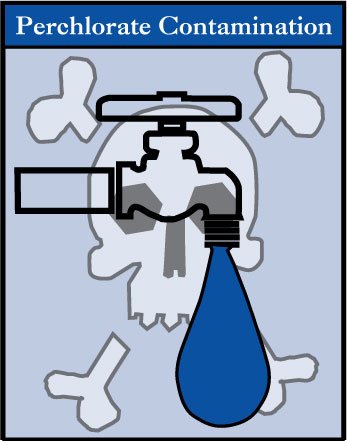Weekly question-and-answer feature on the perchlorate water
contamination in South Valley. Please e-mail your questions to
ed****@****ic.com or fax to 842-2206. We’ll research it and provide
the best answer we can.
Q. What maximum level of perchlorate in water (in parts per
billion) is the Department of Defense lobbying the Environmental
Protection Agency to establish?
Weekly question-and-answer feature on the perchlorate water contamination in South Valley. Please e-mail your questions to ed****@****ic.com or fax to 842-2206. We’ll research it and provide the best answer we can.
Q. What maximum level of perchlorate in water (in parts per billion) is the Department of Defense lobbying the Environmental Protection Agency to establish?
A. Kevin Mayer, regional perchlorate coordinator for the EPA, responds: “Defense Department and aerospace industry experts have suggested that human clinical trials show no adverse effects at approximately 200 ppb. There have also been a number of studies of large populations exposed to perchlorate that do not show a pattern of thyroid-related health problems.
Some of these experts suggest that a partial uncertainty factor might be appropriate to protect sensitive subpopulations, since the 37 subjects of the human clinical study were all healthy adults. This would bring the level down to 70 ppb. Both U.S. EPA and the State of California have suggested additional uncertainty factors should be applied to this study, which would bring the level to below 10 ppb.”
Q. Given current ground and surface water conditions, how many decades can perchlorate persist?
A. According to experts at the Santa Clara Valley Water District, perchlorate is very stable in groundwater. It does not biodegrade unless there is an absence of available dissolved oxygen. Groundwater has naturally occurring dissolved oxygen, which microbes will use before turning to other sources, so natural biodegradation of perchlorate is unlikely.
In the Olin Corp. case, perchlorate may have started slowly entering the soil as many as 48 years ago until, over time, there is so much perchlorate that a plume nearly 8-miles long results. Perchlorate may disperse in the aquifer as it flows downgradient – or flows downstream underground – to the extent that it may not be detectable using available analytical methods, but it won’t disappear. The length of time that perchlorate will remain in the aquifer at detectable levels depends on groundwater flow rates, dispersion and the degree of groundwater pumping.
Introduction of clean water through streams and recharge operations may dilute the perchlorate to levels below our ability to detect it.
Q. It’s been said that “the solution to pollution is dilution.” If so, why doesn’t the perchlorate plume die off as it
travels through the aquifers?
A. According to experts at the Santa Clara Valley Water
District, the pattern of perchlorate distribution in the aquifer may reflect the continuous release, albeit in low levels, of perchlorate at the Olin site for decades.
The low concentrations are probably due to dilution from long well screens in which perchlorate enters in one zone but clean water enters along other portions of the well screen, resulting in a mixing of water from different vertical zones. This mixing dilutes of perchlorate concentration.
Another factor that might contribute to the widespread but low levels of perchlorate is the substantial amount of groundwater pumping occurring in the Llagas sub-basin. Irrigation pumping may result in a more diffuse occurrence of perchlorate as it has been removed by pumping and reintroduced through irrigation.
Similarly, domestic well users, while pumping a good deal less water, release pumped water back to the ground through their septic systems. Research by the University of Pennsylvania suggests that the extremely low level of oxygen present in septic tanks may assist the biological reduction of perchlorate into harmless byproducts – chlorine and oxygen, because chlorine is made up of one atom of chlorine and four atoms of oxygen.
Q. Do safer substitutes for perchlorate exist, so that manufacturers of fireworks, road flares, automobile air bags, etc. won’t pollute ground water in the future?
A. Mayer responds: “There are some substitutes for perchlorate for certain applications. For example, NASA researchers recently announced some encouraging results for rocket propellant alternatives.
Perchlorate can be handled quite safely to avoid environmental threats. Most of our current problems with perchlorate in the environment resulted from past practices before the health hazards of perchlorate were understood.”
Q. Why do some wells test positive, then negative, for perchlorate?
A. According to the EPA’s Mayer, perchlorate is very mobile in groundwater. Changes in pumping or rainfall, among other factors, can alter the direction that the water flows. Even very slight changes in flow patterns can bring water of a different quality to the well.
Q. How many negative tests for perchlorate over what period of time must a well receive before the well owner can feel safe using the well water?
A. Mayer responds: “The data for an individual well provides a partial picture. Groundwater scientists, hydrogeologists, look at information from wells throughout the aquifer to predict contamination patterns. The prediction would be specific to a particular aquifer and often to a particular chemical.”














